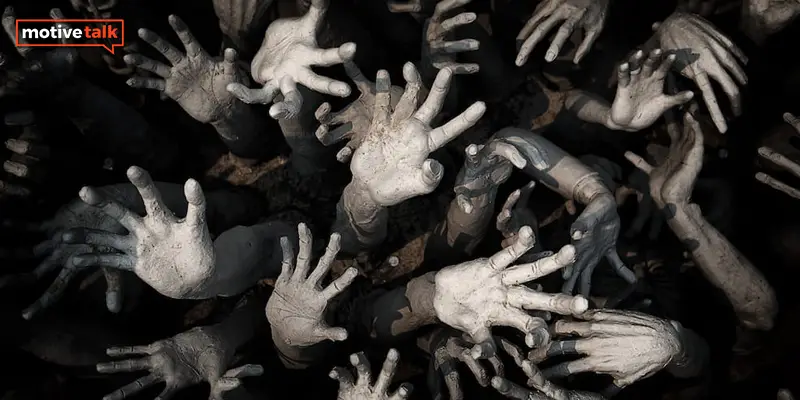Health & Fitness
All You Need To Know On What is Zombie Virus: Is it Deadly or Not?

Many glaciers and permafrost have been steadily melting for years due to the acceleration of global warming. This permanent melting of the permafrost has released several viruses and bacteria that have been dormant on the ice for a long time.
Let’s get to know what is zombie virus?
The zombie virus is a pathogen that has emerged from the submerged ice. Because the ice protects them, these viruses can hibernate. Here, Dr. Swati Rajagopal, Consultant in Infectious Diseases and Travel Medicine at Bangalore’s Aster CMI Hospital, discusses the resurgence of these viruses due to climate change.
What Is A Zombie Virus?
Permafrost, defined as frozen soil for at least two years, is home to the zombie virus.
According to Assistant Professor Jeremy Barr of Monash University, permafrost soil samples thawed in a lab may reanimate and reinfect zombie viruses “frozen in time.”
They are considered “zombies” because of their resuscitation.
What Did Scientists Find?
University of Aix-Marseille researchers discovered that Acanthamoeba DNA viruses, which infect single-celled organisms found in soil or water, may stay infectious for 48,500 years.
The study report states that “It is thus likely that ancient permafrost (ultimately much older than 50,000 years, our limit solely dictating the validity range of radiocarbon dating) will release these unknown viruses upon thawing.”
It is currently hard to determine how long these viruses may stay infectious once exposed to outdoor settings (UV light, oxygen, heat), much alone the likelihood that they would contact and infect a compatible host in that period. However, this threat will only grow in the context of global warming, as permafrost melting will continue to accelerate, and more people will move to the Arctic in response to industrial endeavors.
According to the study’s authors, the number of zombie viruses preserved in permafrost is likely large and poses a potential risk to public health.
No other report has been regarding “live” viruses since the two initial experiments.
This gives the false impression that ‘zombie viruses’ are not a public health risk and that outbreaks of this kind are uncommon.
The research also cautioned that zombie viruses weren’t simply a threat to single-celled creatures but also people.
Professor emeritus of medicine and genomics Jean-Michel Claverie has discovered seven distinct zombie virus families aged 27,000 to 48,500 years.
He told CNN that the viruses that infect amoebas serve as “surrogates” for other viruses that may be present in the permafrost.
He said the remnants of “many, many, many other viruses” are evident.
Therefore, we may safely assume their presence. Whether or not they are still alive is unknown. However, we reasoned that if amoeba viruses are still alive and able to infect their hosts, then there is no reason to believe that the other viruses are not still alive as well.
What Is A Zombie Virus: Are Zombie Viruses Dangerous?
No, to put it briefly.
Although Barr found it “surprising,” it is common knowledge that viruses may survive in a frozen state for extended periods.
He said, “We freeze virus samples all the time and we can bring them out of the freezer and they’ll still be functional.” He worked in a lab at Monash University.
The amoeba in the soil samples, not people, was the primary focus of the study, according to Barr.
“Although they have been around for 50,000 years, these viruses only affect amoeba. It’s quite probable that those amoeba were present in those soil samples around the time those viruses were frozen,” he stated.
What Is Zombie Virus: Common Zombie Myths Explained
There is a lengthy history of fiction, including zombies. Almost all of these have some basis in science:
Can fungal infections impact human behavior?
In the video game-turned-HBO series The Last of Us, cordyceps cause a global zombie apocalypse. Parasitic cordyceps fungus infects the host and then spreads to other people through the host’s fungal spores or mycelia (tendrils).
Cordyceps is a parasitic fungus that only infects certain kinds of insects in certain regions; it cannot spread to humans. There are more than 750 kinds of cordyceps; each one works against a different insect pest. Two of those species may be helpful to human health. But should we be worried that cordyceps may cause a fungal illness in humans?
Dr. Misra explains that it’s very improbable that cordyceps could cross species and infect a human as they do in the episode. However, the idea that fungi may acquire thermotolerance (resistance to high temperatures) and infect people with a greater body temperature than usual is essential to consider.
This is occurring at this very moment. It seems likely that global warming, higher temperatures, and a greater population of individuals with weaker immune systems are making it more feasible for specific fungi like Candida auris to cause new and widespread illnesses.
Can viruses change our DNA?
Differentiating Resident Evil from other zombie fiction is the emphasis on the premise that a zombie infection might modify your genetic code. These changes ultimately result in substantial physical modifications permanently affecting the sick individual.
According to Dr. Misra, “this concept is based on truth.” “Because of their basic structure, viruses are incapable of self-replication. To replicate and spread, viruses need the resources of their host cells. To do this, some viruses introduce their DNA or RNA into human cells.
Contrary to what you would read in zombie fiction, the genetic alterations caused by viruses are often relatively minor.
Imagine the nucleus of each cell in your body to be a library, with books of genetic information (DNA) and functional copies of that information (RNA) that explain how to carry out various biological processes, and each cell to be a small city.
Because viruses lack the resources to replicate themselves in large numbers, they rely on host cells’ libraries (your nuclei) to carry out this task. Retroviruses, a subset of viruses, replicate by inserting their genetic code into otherwise average, bound volumes of DNA. This DNA and bits of the retrovirus are replicated into new cells during cell division, allowing the virus to spread beyond the initial site of infection.
The retrovirus may also infect a germ cell, a reproductive cell. That’s bad news since it means your progeny could get some retroviral DNA. What began as a harmless virus eventually gets incorporated into your DNA. In reality, dormant virus fragments account for around 8% of the human genome.
According to Dr. Misra, this has been going on for millions of years, and viruses infect and integrate into the human DNA.
The following are examples of retroviruses that might cause changes to your DNA:
- Human papilloma virus (HPV)
- Epstein-Barr virus (EBV)
- Hepatitis B
- Hepatitis C
- Human immunodeficiency virus (HIV)
Although these retroviruses leave long-lasting consequences, they are avoidable, and several treatment options for each, such as vaccinations, antibiotics, pre-exposure prophylaxis (PrEP), and over-the-counter medicine may assist with zombie virus symptoms.
Can infections cause changes in your brain?
Ailments’ effects on the brain are a recurring theme in zombie literature, but are there any real-world ailments that interfere with one’s capacity to think clearly?
When untreated, infections with certain viruses, bacteria, parasites, and fungi may lead to inflammation in and around the brain.
The meninges, which protect the brain and spinal cord, become inflamed in meningitis. This may cause mental and physical zombie virus symptoms such as muddled thinking, fatigue, loss of appetite, hallucinations, and distraction.
Inflammation of the brain itself, or encephalitis, is another possible outcome. Behavior changes, disorientation, trouble communicating or moving, memory loss, and seizures are all zombie virus symptoms of encephalitis. Infection with a virus, such as those responsible for:
- HIV
- Herpes simplex
- West Nile virus
- Enteroviruses
In the words of Dr. Misra, “Encephalitis typically has mild initial zombie virus symptoms but can progress to confusion, agitation, or hallucinations.” “Because it affects a specific region of your brain, it can also result in a loss of consciousness, including comas.”
Another well-known virus that may induce abnormal behavior and, ultimately, death is the rabies virus (RABV). A bite or other breach in the skin is the most common route for this virus to enter the body and propagate. There is a vaccination that may prevent illness after a bite. However, you may have the following signs and zombie virus symptoms if you delay treatment:
- Increased aggression or agitation
- Restlessness
- Hallucinations
- Muscle twitching
- Racing heart (tachycardia)
- Hyperventilation
- Delirium
Conclusion about Zombie Virus
These events have brought attention to the potential dangers of global warming, and if permafrost continues melting, we’ll be in much more danger. Viruses are ubiquitous, although not all of them cause illnesses or infections. However, we need additional monitoring to comprehend the threat these infections offer, and we should stress the underlying notion of global warming danger.
You may also read
-
Who is3 months ago
Who Is Fauzia Mubarak Ali? Famous Cat Stevens Wife & Their Children (Update: Jan 2024)
-
Comics9 months ago
Best Shrek Quotes About Life From The Shrek Series
-
Miscellaneous2 years ago
Lone Wolf Quotes – That Will Trigger Your Soul and Mind
-
Miscellaneous7 months ago
Warrior Quotes – That Will Make You More Stronger
-
Miscellaneous11 months ago
Top 27 Letterkenny Quotes – That Will Make Anyone Laugh
-
Super Hero2 years ago
Captain America Quotes – All Are Ultimate Leadership Quotes
-
Politicians2 years ago
Most Powerful Vladimir Putin Quotes – That Will Blow Your Mind
-
Miscellaneous2 years ago
Dalai Lama Quotes – That Will Change Your Values and Vision

































